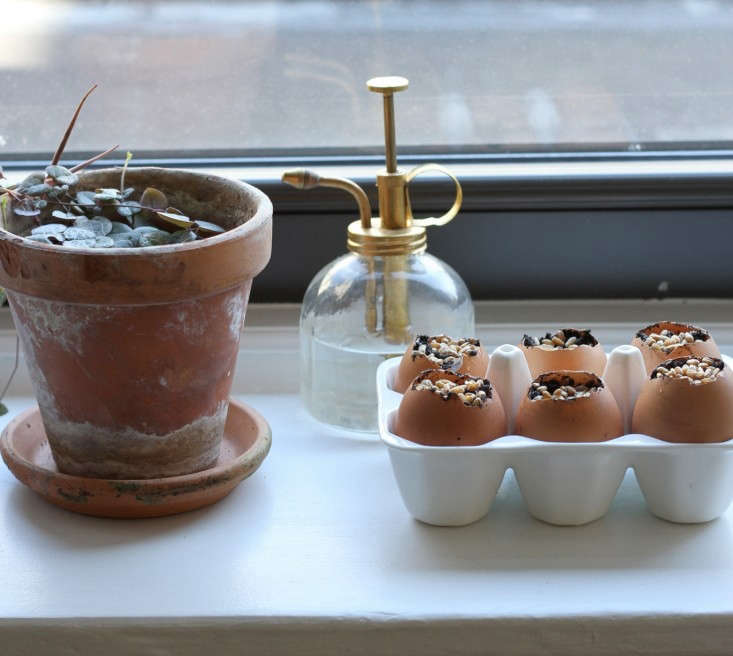Starting vegetables from seed may have been the single most satisfying thing I’ve ever done in my gardening career so far. No matter that my crops ended up inedible (go here to find out why), those early days when little sprouts started to peek through the soil were just glorious. My plant babies were adorable, and I couldn’t have been prouder.
Erin Benzakein, founder of Floret Flower Farm in Washington’s Skagit Valley, knows well that rush of pride and joy: “Starting from seed allows you to enjoy the full experience of gardening—from opening the seed packet, preparing the soil, and sowing your seeds to anxiously anticipating the day when new growth appears. I strongly feel that starting flowers from seed puts us more in tune with nature and the seasons. And there are few things more satisfying than harvesting armloads of flowers that you nurtured from seed.”
Lately, I’ve been pining for that feeling of achievement again, of starting a plant from seemingly nothing. But knowing that many seeds need to be started and cared for indoors before transplanting them outdoors, I’m nervous that I may not be up to the task. Erin, author of the best-selling book Floret Farm’s Cut Flower Garden, put my mind at ease.
1. What are the pros and cons of starting from seed?

“Starting your own seeds is a great way to get a jump on the season. It also gives you access to an incredible array of colors and varieties of plants that you won’t find at your local nursery or big box store. Plus, it is the most affordable way to fill your garden fast,” says Erin.
That said, “when you start your plants from seed, you will need to have at little time and patience to care for your seedlings. It isn’t as simple as throwing seeds into the dirt and walking away. To ensure healthy and vigorous plants, most flower varieties need to be started indoors and planted out once the weather warms in the spring. To start seeds indoors, you need to make sure they have enough water, heat, and light. There’s a little effort involved, but it is definitely worth it!”
2. Which plants can be directly sown in the garden?

Most plants, says Erin, need to be started indoors; at her farm, she starts roughly 90 percent of her flower seeds indoors. However, some fast-growing summer annuals such as grains, grasses, sunflowers, and zinnias, which all sprout within a few days of seeding, and many hardy annuals like larkspur and love-in-a-mist, can be sown directly in the garden. In addition, “many edibles are easy to grow from seed, especially squash. After all danger of frost has passed, you can directly sow the seeds, and in less than two weeks you should see tiny plants emerge from the ground,” says Erin.
3. Which plants are particularly hard to grow from seed?

“There are a few flowers you’ll want to buy as seedlings or ‘plugs’ as they are called by most flower growers,” shares Erin. “Lisianthus is one of these, as it’s incredibly slow to germinate. Some people like buying perennial plants as seedlings; starting them from seed is definitely possible, but requires a higher level of care and patience.”
4. What do you need to start seeds indoors?

Not much. In addition to the seeds, you’ll need a seed-starting cell flat (or any kind of vessel that drains well—egg cartons, DIY newspaper pots, Dixie cups all work). More supplies:
- Tray underneath the cell flat (to hold water, as watering from the bottom is preferable to watering from above; tiny seeds can accidentally wash away)
- Dome-shaped cover to capture humidity
- Seed-starting soil mix (Erin recommends this)
In addition, you’ll need to find a spot with ample light (either natural or electric), and warmth. Aside from in a greenhouse, on top of a refrigerator or on a radiator are other great spots to place your seed starters for added warmth. (Go here and here for great tutorials on how to start from seed on Erin’s site.)
5. When should you start from seed?

When to start is dependent on two factors: the germination time and the optimal time to transplant them outdoors. For instance, for nasturtiums (an edible flower that Erin adores because “they can add so much beauty to an ordinary salad”), “you’ll want to start these seeds indoors in pots four to six weeks before your last spring frost and then transplant out after all danger of frost has passed.” Different varieties have different germination times and planting requirements, so always do your research before you start.
For more great advice from Erin, see Ask the Expert: 7 Tips to Grow Cut Flowers in a Tiny Garden, from Floret Farm.
For more about starting from seed, see:
- Gardening 101: How to Sprout a Seed
- A Grow Light for Houseplants That Will Change Your Life
- 10 Easy Pieces: Grow Lights for Indoor Plants
- Gardening 101: How to Use Eggshells in the Garden
For more in the Your First Garden series, see:
- Your First Garden: How to Start a Garden for Practically Free
- Your First Garden: The Easiest Vegetables to Grow
- Your First Garden: 10 Compelling Reasons to Plant a Container Garden








Have a Question or Comment About This Post?
Join the conversation